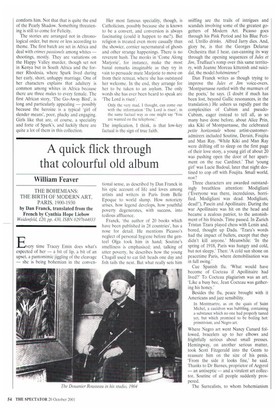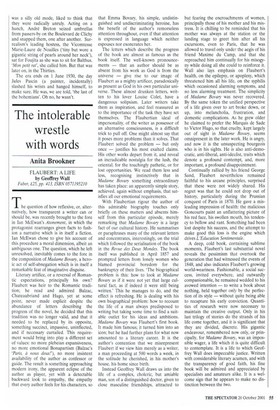A quick flick through that colourful old album
William Feaver
THE BOHEMIANS: THE BIRTH OF MODERN ART, PARIS, 1900-1930 by Dan Franck, translated from the French by Cynthia Hope Liebow
Weidenfeld, 120, pp. 430, ISBN 0297644033
Every time Tracey Emin does what's expected of her — a bit of lip, a bit of an upset, a pantomimic jiggling of the cleavage — she is being bohemian in the conven
tional sense, as described by Dan Franck in his epic account of life and loves among artists and writers in Paris from Belle Epoque to world slump. How notoriety arises, how legend develops, how youthful poverty degenerates, with success, into tedious affluence.
Franck, 'the author of 20 books which have been published in 28 countries', has a nose for detail. He mentions Picasso's neglect of personal hygiene before the genteel Olga took him in hand; Soutine's smelliness is emphasised; and, talking of utter poverty, he describes how the young Chagall used to eat fish heads one day and fish tails the next, But what really sets him
sniffing are the trails of intrigues and scandals involving some of the greatest gogetters of Modern Art. Picasso goes through his Pink Period and his Blue Period. Utrillo drinks. Alfred Jarry dies. And, glory be, is that the Georges Delarue Orchestra that I hear, can-canning its way through the opening sequences of Jules et Jim, Truffaut's romp over this same territory, with Jeanne Moreau kittenish and suicidal, the model bohemienne?
Dan Franck writes as though trying to improve the Jules et Jim voice-overs. 'Montparnasse rustled with the murmurs of the poets,' he says. (I doubt if much has been lost, beyond Gallic resonances, in the translation.) He ushers us rapidly past the complexities of Cubism and pseudoCubism, eager instead to tell all, as so many have done before, about Alice Prin, aka Kiki of Montparnasse, the celebrated petite hofizontale whose artist-customeradmirers included Soutine, Derain, Foujita and Man Ray. 'While Kiki and Man Ray were drifting off to sleep on the first page of their love story, a young girl of about 20 was pushing open the door of her apartment on the rue Cardinet.' That 'young girl' was Lucie Badoul, later that night destined to cop off with Foujita. Small world, non?
Three characters are awarded outstandingly breathless attention: Modigliani (Everyone was there, incredulous, horrified. Modigliani was dead. Modigliani, dead!'), Pascin and Apollinaire. During the war Apollinaire was hit on the head and became a zealous patriot, to the astonishment of his friends. Time passed. In Zurich Tristan Tzara played chess with Lenin and, bored, thought up Dada. `Tzara's words had the impact of bullets, except that they didn't kill anyone.' Meanwhile: 'In the spring of 1918, Paris was hungry and cold, but not sleepy.' Then: 'A cold sun shone on peacetime Paris, where demobilisation was in full swing.'
Cue Spanish flu. 'What would have become of Cocteau if Apollinaire had lived?' To Cocteau plagiarism was an art. 'Like a busy bee, Jean Cocteau was gathering his honey.'
Besides the flu, peace brought with it Americans and jazz sensibility.
In Montmartre, as on the quais of Saint Michel, a cauldron was bubbling, containing a substance which no one had properly tasted yet, but which promised to be boiling hot: primitivism, and Negro art.
Where Negro art went Nancy Cunard followed, bracelets up to her elbows and frightfully serious about small presses. Hemingway, on another serious matter, took Scott Fitzgerald into the Gents to reassure him on the size of his penis. 'From the side it looks fine,' he said. Thanks to Dr Barnes, proprietor of Argyrol — an antiseptic — and a virulent art collector, Soutine of all people suddenly prospered.
The Surrealists, to whom bohemianism was a silly old mode, liked to think that they were radically unruly. Acting on a hunch, Andre Breton seized umbrellas from passers-by on the Boulevard de Clichy and snapped them, one after another. Surrealism's leading hostess, the Vicomtesse Marie-Laure de Noailles ('tiny but wore a gigantic string of pearls around her neck'), sat for Foujita as she was to sit for Balthus. Mon petit rat', she called him. But that was later on, in the Thirties.
The era ends on 1 June 1930, the day Jules Pascin (a painter, incidentally) slashed his wrists and hanged himself, to make sure, He was, we are told, 'the last of the bohemians'. Oh no, he wasn't.



























































































 Previous page
Previous page